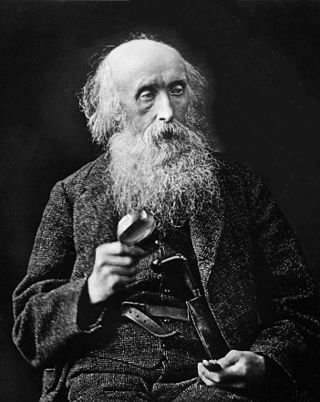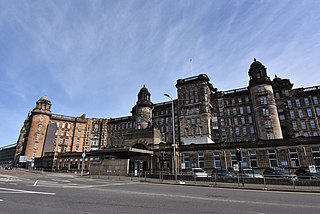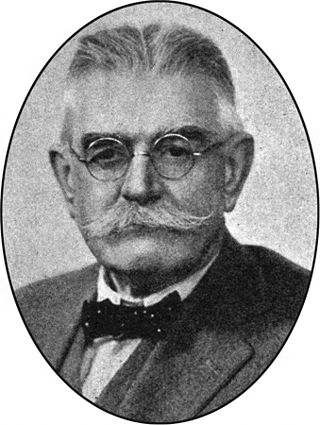
The Dean Cemetery is a historically important Victorian cemetery north of the Dean Village, west of Edinburgh city centre, in Scotland. It lies between Queensferry Road and the Water of Leith, bounded on its east side by Dean Path and on its west by the Dean Gallery. A 20th-century extension lies detached from the main cemetery to the north of Ravelston Terrace. The main cemetery is accessible through the main gate on its east side, through a "grace and favour" access door from the grounds of Dean Gallery and from Ravelston Terrace. The modern extension is only accessible at the junction of Dean Path and Queensferry Road.

A Regius Professor is a university professor who has, or originally had, royal patronage or appointment. They are a unique feature of academia in the United Kingdom and Ireland. The first Regius Professorship was in the field of medicine, and founded by the Scottish King James IV at the University of Aberdeen in 1497. Regius chairs have since been instituted in various universities, in disciplines judged to be fundamental and for which there is a continuing and significant need. Each was established by an English, Scottish, or British monarch, and following proper advertisement and interview through the offices of the university and the national government, the current monarch still appoints the professor. This royal imprimatur, and the relative rarity of these professorships, means a Regius chair is prestigious and highly sought-after.

John Hutton Balfour was a Scottish botanist. Balfour became a Professor of Botany, first at the University of Glasgow in 1841, moving to the University of Edinburgh and also becoming the 7th Regius Keeper of the Royal Botanic Garden Edinburgh and Her Majesty's Botanist in 1845. He held these posts until his retirement in 1879. He was nicknamed Woody Fibre.

Sir William Macewen, was a Scottish surgeon. He was a pioneer in modern brain surgery, considered the father of neurosurgery and contributed to the development of bone graft surgery, the surgical treatment of hernia and of pneumonectomy.
Macewen's sign or Macewen sign is a sign used to help to diagnose hydrocephalus and brain abscesses. Tapping (percussion) the skull near the junction of the frontal, temporal, and parietal bones will produce cracked pot sound. Positive test is indication of separated sutures. This is due to raised intracranial tension.

The Glasgow Royal Infirmary (GRI) is a large teaching hospital. With a capacity of around 1,000 beds, the hospital campus covers an area of around 8 hectares, and straddles the Townhead and Dennistoun districts on the north-eastern fringe of the city centre of Glasgow, Scotland. It is managed by NHS Greater Glasgow and Clyde. It was originally opened in 1794, with the present main building dating from 1914.

James Hogarth Pringle was an Australian-born British surgeon in Glasgow, who made a number of important contributions to surgical practice. He is most famous for the development of the Pringle manoeuvre, a technique still used in surgery today.

The Regius Chair of Chemistry at the University of Glasgow was founded in 1817 by King George III, who also established the Regius Chairs of Surgery and Natural History at the university. The chair originated from a lectureship in chemistry, established in 1747.

The Memorial Gates at the University of Glasgow were erected in 1952 as a celebration of the university's quincentenary, or five hundredth anniversary. They form a portal through the University Avenue side of the perimeter fence around the university's current site on Gilmorehill. They stand before the Hunter memorial and Hunterian Museum, on the other side of the John McIntyre Building from the Main Gate. The large gates in the centre are generally locked, although the small pedestrian gates to the left and right are opened during the day. The gates bear the names of thirty distinguished figures associated with the university. The gates are protected as a category B listed building.

Charles Frederick William Illingworth was a British surgeon who specialised in gastroenterology. Along with a range of teaching and research interests, he wrote several surgical textbooks, and played a leading role in university and medical administration.

Scottish education in the nineteenth century concerns all forms of education, including schools, universities and informal instruction, in Scotland in the nineteenth century. By the late seventeenth century there was a largely complete system of parish schools, but it was undermined by the Industrial Revolution and rapid urbanisation. The Church of Scotland, the Free Church of Scotland and the Catholic church embarked on programmes of school building to fill in the gaps in provision, creating a fragmented system. Attempts to supplement the parish system included Sunday schools, mission schools, ragged schools, Bible societies and improvement classes. Scots played a major part in the development of teacher education with figures including William Watson, Thomas Guthrie, Andrew Bell, John Wood and David Stow. Scottish schoolmasters gained a reputation for strictness and frequent use of the tawse. The perceived problems and fragmentation of the Scottish school system led to a process of secularisation, as the state took increasing control. The Education (Scotland) Act 1872 transferred the Kirk and Free Kirk schools to regional School Boards and made some provision for secondary education. In 1890 school fees were abolished, creating a state-funded, national system of compulsory free basic education with common examinations.
Prof George Henry Edington FRSE FRCS DL JP TD (1870-1943) was a Scottish surgeon, anatomist and medical author who served as President of both the Glasgow Medico-Chirurgical Society and the Royal Faculty of Physicians and Surgeons of Glasgow 1928 to 1940. He was Honorary Physician to King George V from 1922 to 1927.

Sir George Husband Baird MacLeod (1828-1892) was Regius Professor of Surgery at Glasgow University. He was Surgeon in Ordinary to Queen Victoria when in Scotland and was knighted by her in 1887.

Sir Hector Clare Cameron, was a surgeon who was most notable for being Emeritus Professor of Clinical Surgery at the University of Glasgow and President of the Faculty of Physicians and Surgeons of Glasgow between 1897 and 1900. Cameron was house-surgeon to Joseph Lister and by 1887 assisted him in private practice. They eventually became life-long friends.

Thomas Kennedy Dalziel, known as T Kennedy Dalziel, was a Scottish surgeon and pathologist who specialised particularly in abdominal surgery. Dalziel was most notable for being considered the best technical surgeon at the time in western Scotland. He was also particularly notable for the discovery of a disease called chronic interstitial enteritis in 1913, that later became known as Crohn's disease.

Andrew Victor Biankin is a Scotland-based Australian clinician-scientist, best known for his work on enabling precision oncology in learning healthcare systems by integrating discovery, preclinical and clinical development to accelerate novel therapeutic strategies, and developing standardised pan-cancer assays for use by healthcare systems and researchers worldwide.
Extramural medical education in Edinburgh began over 200 years before the university medical faculty was founded in 1726 and extramural teaching continued thereafter for a further 200 years. Extramural is academic education which is conducted outside a university. In the early 16th century it was under the auspices of the Incorporation of Surgeons of Edinburgh (RCSEd) and continued after the Faculty of Medicine was established by the University of Edinburgh in 1726. Throughout the late 18th and 19th centuries the demand for extramural medical teaching increased as Edinburgh's reputation as a centre for medical education grew. Instruction was carried out by individual teachers, by groups of teachers and, by the end of the 19th century, by private medical schools in the city. Together these comprised the Edinburgh Extramural School of Medicine. From 1896 many of the schools were incorporated into the Medical School of the Royal Colleges of Edinburgh under the aegis of the RCSEd and the Royal College of Physicians of Edinburgh (RCPE) and based at Surgeons' Hall. Extramural undergraduate medical education in Edinburgh stopped in 1948 with the closure of the Royal Colleges' Medical School following the Goodenough Report which recommended that all undergraduate medical education in the UK should be carried out by universities.
George Buchanan, LRCS was a Scottish surgeon.














